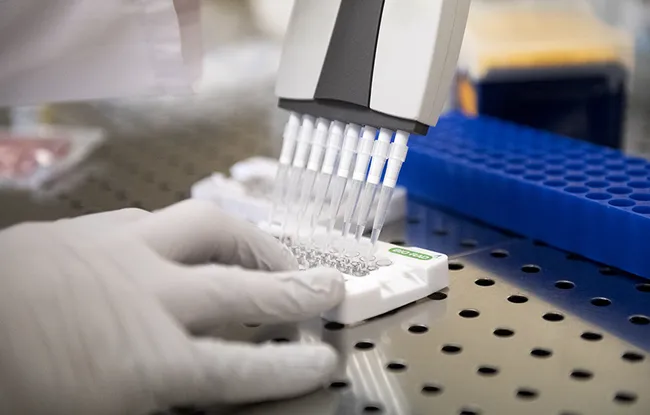- Home >
- Institut Curie News >
- Technological revolution: chemical innovation at the service of "Next-Generation Sequencing" (Next-Generation Sequencing = NGS)
In 2005, the British company Solexa*, based in Cambridge (UK), uses for the first time its new NGS technology in order to decipher the genomic sequence of the bacteriophage phiX174 in an ultra-fast way and with unparalleled precision. Today, many teams at Institut Curie are using this technology in fundamental and applied research, in particular to characterize the biology of cancers. NGS can rapidly obtain accurate cancer genomes and transcriptomes using reversible termination chemistry and single-molecule fluorescence microscopy. Before achieving this, Solexa researchers had to face several major challenges.
First challenge: to develop a reversible protective group for one of the ends of the DNA and a series of fluorescent bases for their detection after incorporation by synthesis.
An innovative approach allowed us to develop NGS as we know it today: the use of a reversible protecting group on the -OH end of DNA. This method consists in incorporating DNA bases, one by one in a controlled manner, using deoxynucleotide triphosphates (dNTP) protected in 3'-OH which makes it possible to block the incorporation of the following dNTP. Each dNTP is labeled on the nitrogen base by a separate fluorophore. Thus, each base can be detected individually and simultaneously by imaging. After acquisition, the protective group can be cleaved and the following base incorporated. In other words, it makes it possible to read the DNA from nucleotide to nucleotide by chemical synthesis and to obtain the precise sequence in record time.
Second challenge: designing an appropriate polymerase
Another challenge for the Cambridge researchers: modifying a natural enzyme, called DNA polymerase, to allow it to read DNA molecules and synthesize the complementary strand, by introducing non-natural dNTPs (protected in 3'-OH and marked with a fluorophore on the nitrogen base). The researchers have created a mutated polymerase capable of binding to natural single-stranded DNA, and introducing dNTPs sequentially. Unlike a natural polymerase which synthesizes the complementary strand without detaching from the single strand of which it is necessary to make the copy, this new polymerase has been developed to detach after introduction of each dNTP in order to be able to detect the fluorescence signal and to carry out the cleavage of the protective group in 3'-OH. Challenges successfully met!
Third challenge: to develop a solid support making it possible to attach the DNA to be sequenced with a reduced fluorescence background noise.
The Solexa teams have designed four dNTPs, each displaying distinct fluorophores and which can be chemically cleaved after each cycle of incorporation by the polymerase. This technique can only be effectively implemented if the synthesis is carried out on a solid support. This makes it possible in fact to have quantitative synthesis yields and to mix the four dNTPs in the reaction medium simultaneously in order to remain in a system of competitive incorporation of the dNTPs by the polymerase. The development of a surface chemistry therefore represents the major challenge faced by the researchers. Each DNA strand had to be immobilized on a solid surface in order to determine which nucleotide could be incorporated on which strand. It was necessary to take into account the efficiency of the DNA attachment chemistry, the stability of this chemistry which must be capable of maintaining the DNA fragment on the surface during numerous synthesis cycles, and present a low fluorescence background noise in order to have a ratio of dNTP fluorescence signal / usable surface background noise. Polyacrylamide was a first option, for its stability potential as well as for its high signal/ noise ratio – the fluorescent signal used to detect DNA bases is stronger than the background noise, thus allowing a clearer and more accurate reading of the data.
Fourth challenge: improving the accuracy of DNA sequencing
In order to improve the detection of each dNTP labeled with a fluorophore (a molecule capable of emitting fluorescence when excited), and to overcome incorrect incorporation of dNTPs, which is inherent in each polymerase, the "molecular clustering" technique was developed by Manteia Predictive Medicine ** and operated by Solexa. Its purpose: to amplify locally each single DNA fragment to be sequenced in order to increase the signal/noise ratio but also to cancel the signal of a dNTP incorrectly incorporated stochastically among others that have been correctly incorporated. This technique consists in locally amplifying each single fragment in order to create a colony of identical copies. This innovation enables faster sequencing, capturing a stronger signal and minimizing sequencing errors.
This work has paved the way for faster, more accurate and more reliable clinical applications. Their insight and risk-taking in the invention of disruptive DNA sequencing technology has not only increased our understanding of diseases like cancer, but has also been crucial to the development of potential treatments.
Reference: R. Rodriguez et Y. Krishnan, The Chemistry of next-Generation Sequencing, Nature Biotechnology, 2023. DOI:10.1038/s41587-023-01986-3
* Solexa has since been acquired by the American company Illumina.
** A Swiss start-up, some of whose technological developments are used in Solexa/Illumina sequencing.
Research News
Discover all our news
Celebration
The Immunity and Cancer research unit (U932) celebrates its twentieth anniversary
12/12/2025
Artificial Intelligence
08/12/2025


